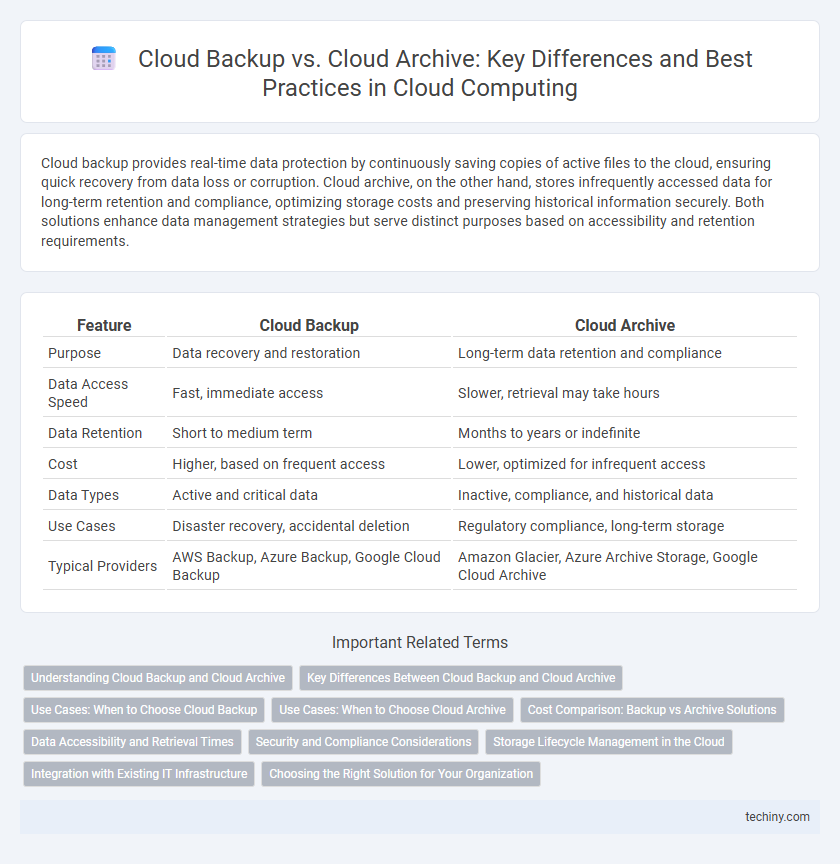Cloud backup provides real-time data protection by continuously saving copies of active files to the cloud, ensuring quick recovery from data loss or corruption. Cloud archive, on the other hand, stores infrequently accessed data for long-term retention and compliance, optimizing storage costs and preserving historical information securely. Both solutions enhance data management strategies but serve distinct purposes based on accessibility and retention requirements.
Table of Comparison
| Feature | Cloud Backup | Cloud Archive |
|---|---|---|
| Purpose | Data recovery and restoration | Long-term data retention and compliance |
| Data Access Speed | Fast, immediate access | Slower, retrieval may take hours |
| Data Retention | Short to medium term | Months to years or indefinite |
| Cost | Higher, based on frequent access | Lower, optimized for infrequent access |
| Data Types | Active and critical data | Inactive, compliance, and historical data |
| Use Cases | Disaster recovery, accidental deletion | Regulatory compliance, long-term storage |
| Typical Providers | AWS Backup, Azure Backup, Google Cloud Backup | Amazon Glacier, Azure Archive Storage, Google Cloud Archive |
Understanding Cloud Backup and Cloud Archive
Cloud backup involves the regular copying and storage of active data to the cloud for quick recovery during data loss or system failure. Cloud archive stores infrequently accessed data long-term, optimized for durability and cost-efficiency rather than speed. Understanding the distinct purposes of cloud backup and cloud archive helps organizations implement effective data management strategies aligned with regulatory compliance and operational needs.
Key Differences Between Cloud Backup and Cloud Archive
Cloud backup and cloud archive serve different data management purposes: cloud backup offers frequent, automated copies of active data for quick recovery during system failures, while cloud archive stores infrequently accessed data long-term to reduce storage costs. Cloud backup emphasizes data restoration speed with short retention periods, whereas cloud archive prioritizes cost efficiency and compliance with extended retention and slower retrieval times. Key differences include backup's role in disaster recovery versus archive's function in compliance and historical record preservation.
Use Cases: When to Choose Cloud Backup
Cloud backup is ideal for businesses requiring quick data recovery after accidental deletion, ransomware attacks, or system failures, ensuring minimal downtime and data loss. It suits environments with frequent data changes, where automated daily or hourly backups are necessary to maintain up-to-date copies. Organizations handling critical operational data prioritize cloud backup to enable rapid restoration and continuity of business processes.
Use Cases: When to Choose Cloud Archive
Cloud archive is ideal for long-term data retention, regulatory compliance, and infrequent access scenarios where cost efficiency and durability are critical. Use cloud archive when storing historical records, legal documents, or backup snapshots that require preservation over years with minimal retrieval needs. Unlike cloud backup, cloud archive emphasizes long-term retention policies and optimized storage costs for inactive data.
Cost Comparison: Backup vs Archive Solutions
Cloud backup solutions typically involve higher costs due to frequent data access and continuous storage updates, while cloud archive solutions offer significantly lower expenses by focusing on long-term retention with infrequent retrieval. Backup services require substantial storage capacity and bandwidth, driving operational expenses up compared to archive services that optimize for cost-efficiency using cold or deep storage tiers. Organizations benefit from selecting archives for compliance or historical data retention, reducing storage fees, versus backups designed for rapid recovery and disaster management with associated premium pricing.
Data Accessibility and Retrieval Times
Cloud backup solutions provide near-instant data accessibility and rapid retrieval times, ensuring critical information is available for immediate recovery or operational continuity. Cloud archiving, designed for long-term data retention, typically features slower retrieval speeds due to optimized storage for infrequent access and regulatory compliance. Enterprises prioritize cloud backup for disaster recovery while leveraging cloud archive to reduce costs for dormant data without compromising compliance requirements.
Security and Compliance Considerations
Cloud backup solutions prioritize rapid data recovery with encrypted storage and transfer protocols to ensure robust security, meeting compliance standards such as GDPR, HIPAA, and SOC 2. Cloud archive services focus on long-term data retention with immutable storage and audit trails, supporting regulatory requirements for data integrity and legal hold. Both emphasize strict access controls and encryption but differ in retention strategies to align with specific compliance frameworks.
Storage Lifecycle Management in the Cloud
Cloud Backup provides short-term data protection by frequently copying active data to the cloud for fast recovery, while Cloud Archive targets long-term storage of infrequently accessed data, optimizing cost and compliance. Storage Lifecycle Management in the cloud automates the transition of data between backup and archive tiers based on predefined policies, ensuring efficient resource utilization and regulatory adherence. Integration of cloud-native lifecycle tools like AWS Lifecycle Manager or Azure Blob Storage lifecycle policies streamlines data retention, reduces storage costs, and enhances data governance.
Integration with Existing IT Infrastructure
Cloud backup seamlessly integrates with existing IT infrastructure by continuously mirroring data and ensuring real-time protection without disrupting business operations. Cloud archive focuses on long-term data retention, optimizing storage costs by moving infrequently accessed data to scalable, low-cost storage tiers compatible with compliance requirements. Both solutions support hybrid environments through APIs and connectors, enabling smooth data management across on-premises and cloud systems.
Choosing the Right Solution for Your Organization
Cloud backup provides real-time or scheduled copying of active data to ensure immediate recovery in case of data loss, while cloud archive offers long-term storage for infrequently accessed information with cost-efficient retention. Choosing the right solution depends on your organization's data usage patterns, compliance requirements, and budget constraints, emphasizing rapid restoration needs versus archival retention policies. Evaluating factors like recovery time objective (RTO), data growth rate, and regulatory mandates helps optimize data protection strategies with either cloud backup or cloud archive services.
Cloud Backup vs Cloud Archive Infographic

 techiny.com
techiny.com